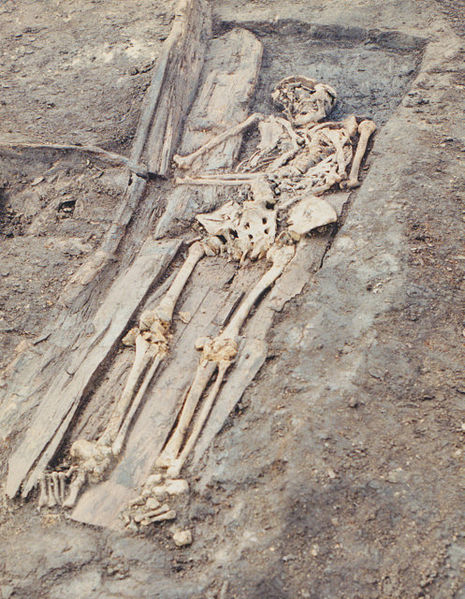Kate - I don't know whether you watch Time Team, but essentially, Tony  Robinson turns up in your back garden and finds a bit of a wall that's meant to be part of a 15th century monastery or something. But also, with a lot of those archaeological programmes, you see them uncovering skeletons, human remains from as far back as the middle ages and earlier.
Robinson turns up in your back garden and finds a bit of a wall that's meant to be part of a 15th century monastery or something. But also, with a lot of those archaeological programmes, you see them uncovering skeletons, human remains from as far back as the middle ages and earlier.
Now, if you've ever seen them uncover a skeleton, you see them brushing away the soil, slowly uncovering the bones before lifting them out. These bones can tell us a lot about how the person lived, what they looked like, how tall they were, and illnesses that they suffered. But you never look at the soil, that's wheelbarrowed away and chucked away somewhere. What some scientists in Denmark are saying this week however, is that that's the wrong thing to do. That soil can actually also tell us a lot about how the humans lived and died.
So, when we die and we're buried, our body and the soft tissues rot away and we're left with the bones. But what they're saying is that all the chemicals and the organic compounds in our tissues go into the soil. A lot of these react with the soil around it or get washed away by ground water, but some of them, in particular, Mercury which is what they're looking at, stick around. If you can find these elements in the soil where the soft tissue was and not in the other soil around it, you know that that's definitely come from the decomposed body.
Now, what Mercury used to be used for in the middle ages is a medicine. We know today that it's pretty poisonous, but it used to be given as a medicine for lots of different illnesses. Archaeologists have long been able to test people's bones to see whether they've been given Mercury. But it only tells us whether they've been given Mercury, years before their death. So, they either have or they haven't. What they can do with this new soil analysis is they can look at the specific soil around where the person's lungs used to be, where their liver used to be, and where their kidney used to be. That can tell us how recently they were given Mercury and how often.
Dominic - So, is that because the Mercury is being transported around the body and depending upon how far it's got, you know how long it's had to get through the bloodstream.
Kate - We know that poisons in our body, when they're taken out of our blood, they get left in our livers and our kidneys which are the parts of our body which clean the poisons out of our bloodstream.
So, Mercury was given as a vapour, you inhaled it, but the Mercury was actually taken out of our lungs fairly quickly, so you know if you can find a high Mercury concentration in where someone's lungs used to be, that they were given Mercury a day, a day and a half before their death.
One of the case studies that they've given is this 10-year-old child and they found that there's a very high concentration of Mercury in their kidney, showing that they were given it quite a long time ago, but also a high concentration in their lungs. So, we can presume from that that this child that had a long illness, they were given Mercury as a treatment, it didn't work. Maybe they got better for a short period of time, but then there was another event, just before they died, a day or so before, that caused them to get gravely ill and they were given a big dose of Mercury to try and get them through that. It didn't work and they died. So, this gives us in far more detail than we've ever been able to know before, exactly what happened in a few days before these people died.
Dominic - So, this is quite a radically new methodology for archaeology. You're having to preserve this soil. I guess there's always this debate over, is it better to dig something up now or do you want to leave it for 10 years until potentially, we have new and better techniques.
Kate - Yes. Well, a lot of that goes in places like China. A lot of the terracotta warriors aren't being dug up at the moment because we hope that our techniques will get better in the future. But what I think people are suggesting here is, while we can think about all the wheelbarrows of soil and information that we've chucked away over the years, if we can take samples now, as long as we keep them around, even if our techniques improve in the future, we'll be able to go back and look at them.
- Previous Quick Fire Science: Meteors
- Next Invisibility with squid skin










Comments
Add a comment